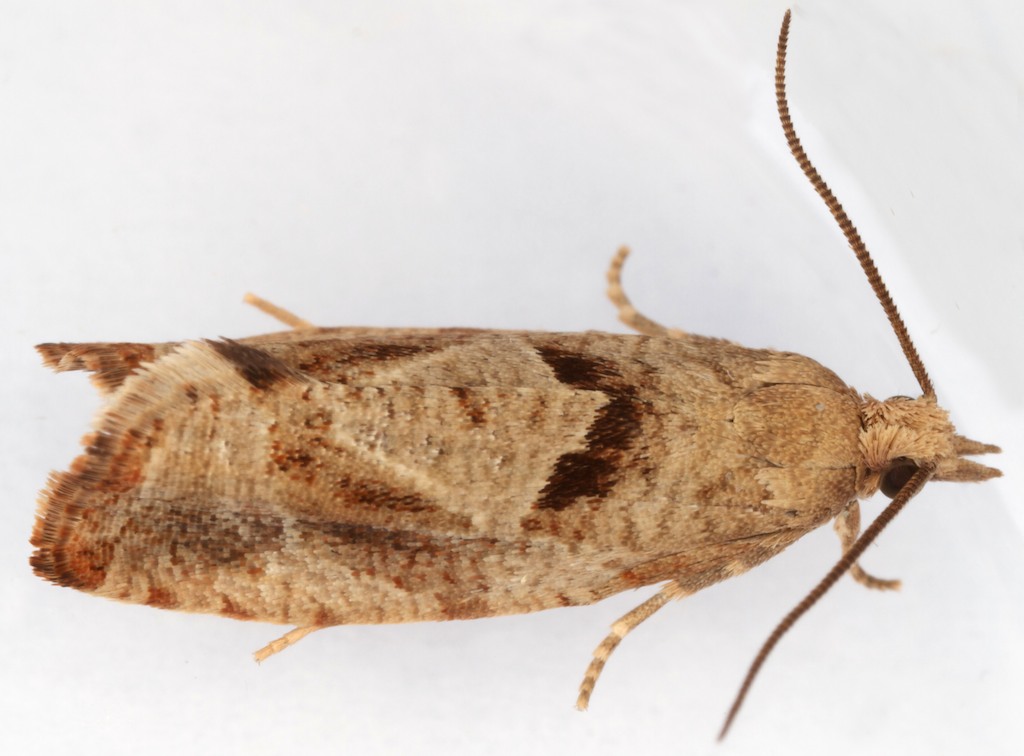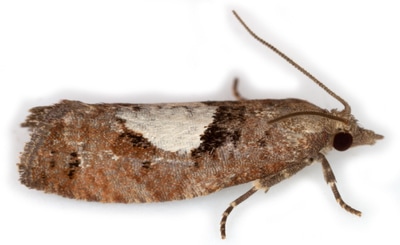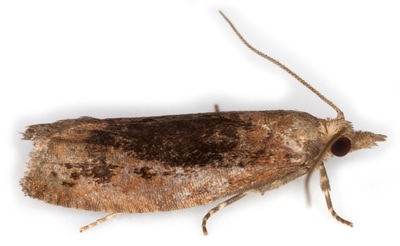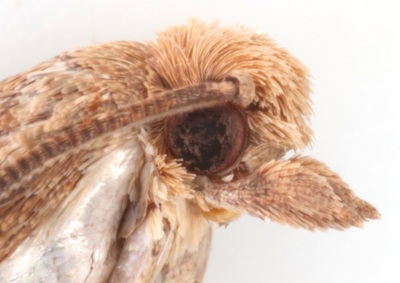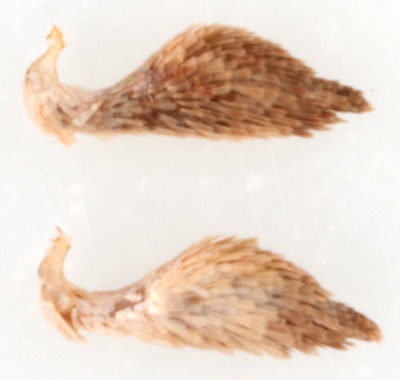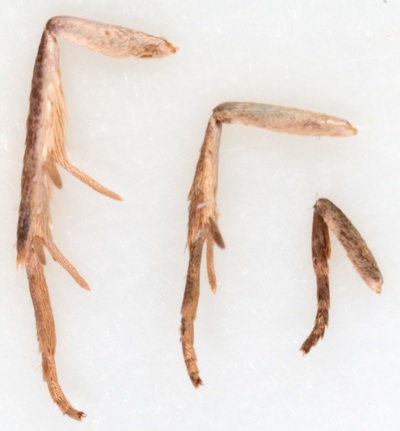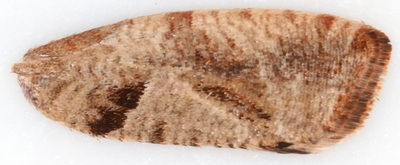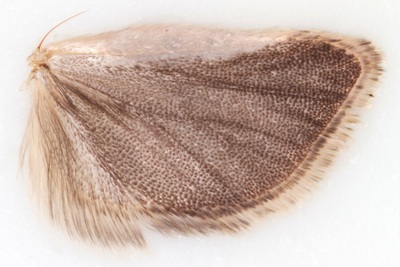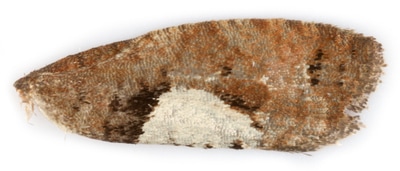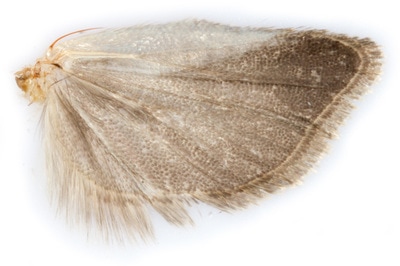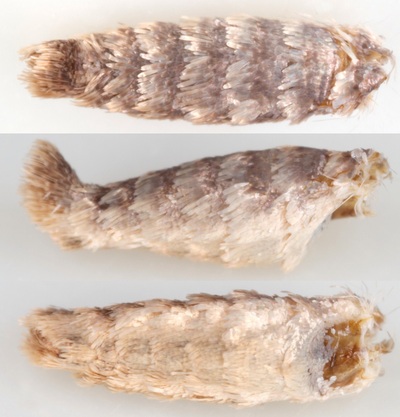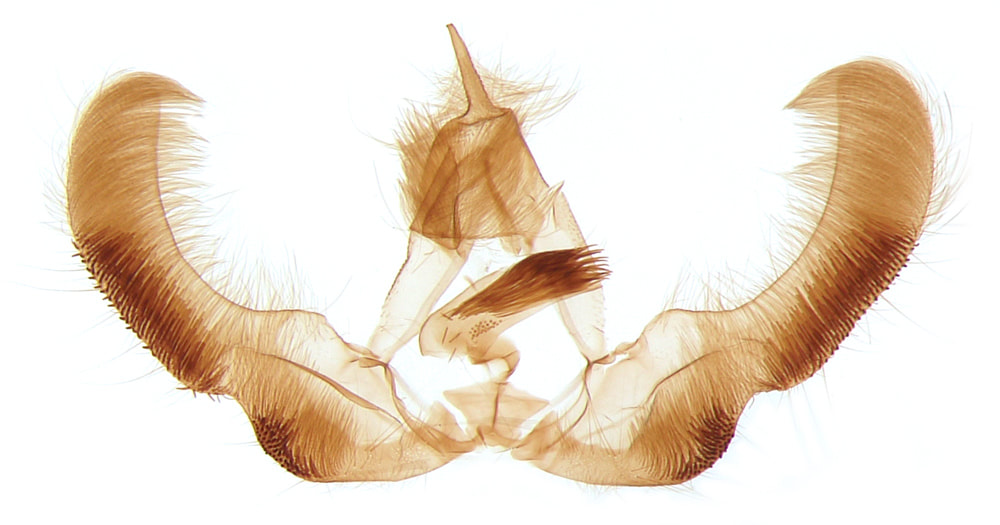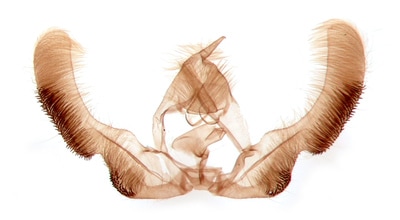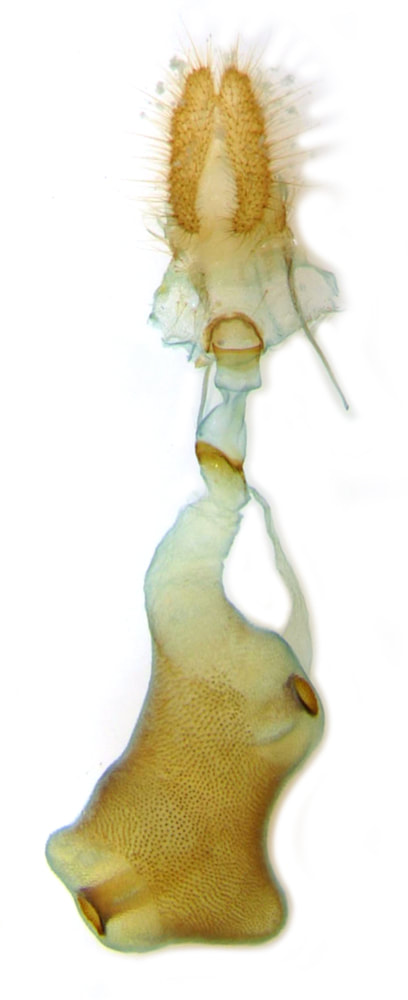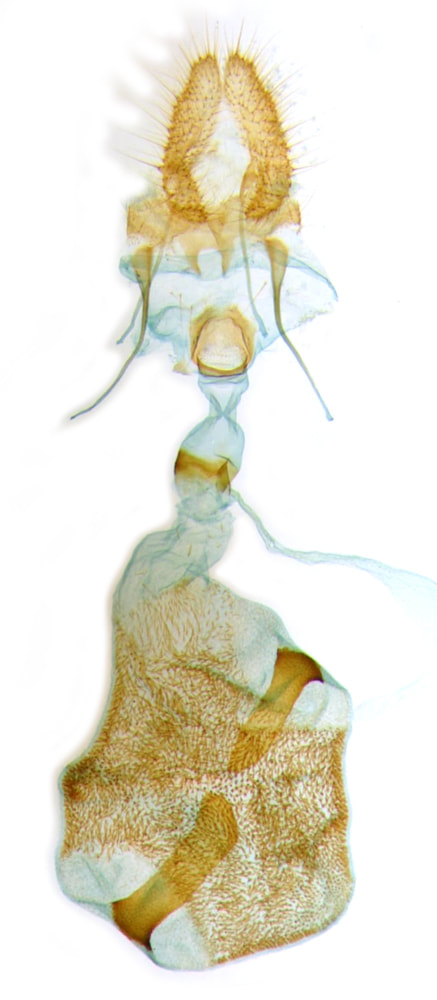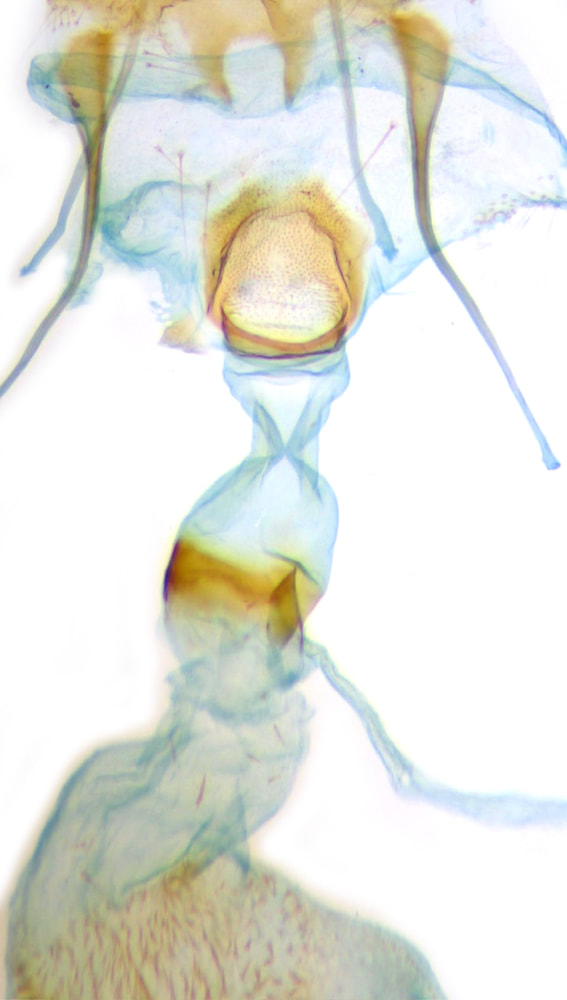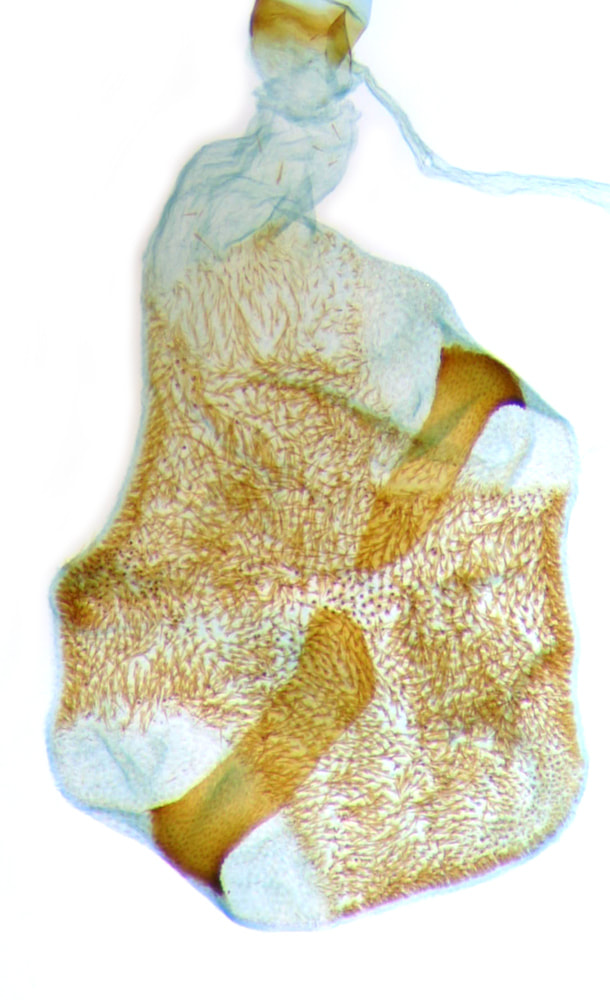49.231 Epinotia brunnichana (Large Birch Roller)
ws: 18-22mm; Jul-Aug; birch (Betula spp), hazel (Corylus avellana), willows (Salix spp); common throughout GB
Synonym: Astatia sinuana (Pierce & Metcalfe)
Synonym: Astatia sinuana (Pierce & Metcalfe)
ID: Polymorphic. In the common forms brunneana and albodorsana - general colour greyish-ochreous to pinkish-brown; distal margin of subbasal fascia strongly angled (pointing distally), dorsal portion of subbasal fascia strengthened with black from the angle to the dorsum; median fascia strongly oblique, narrow at costa, broader medially and confluent with pre-tornal marking. Form albodorsana differs from form brunneana in having a conspicuous white dorsal blotch bounded by the median and subbasal fasciae. The nominate form (brunnichana) is rare in Britain; the basic pattern is the same but it has a whiter ground colour with grey markings and strigulae. Form brunneodorsana is also rare; it has a diffuse semiovate black dorsal blotch from subbasal fascia to tornus. In separating fasciate forms of E.solandriana from similar forms of E.brunnichana, both MBGBI5.2 and BTM mention that the the dorsal blotch is triangular in E.solandriana and subquadrate or trapezoid in E.brunnichana.
Male genitalia: very similar to E.solandriana. Several differences are apparent in the illustrations in MBGBI5.2 (p322 figs 253 & 253) but not all of the differences illustrated provide reliable means if distinguishing the species. 1) the socii of E.solandriana are broader. This feature is probably consistent with images at Moth Dissection, but the difference is relative and not very pronounced. 2) A concavity of the saccular margin is deeper and the saccular margin proximal to the concavity more rounded in E.brunnichana. This feature is not convincingly demonstrated in the images at Moth Dissection and is very liable to variability in rotation of the valvae and degree of flattening achieved in a set specimen. Possibly lateral views of the genitalia before opening out the valvae would determine whether this feature is real. 3) Related to 2) the angle between the base of the saccular margin and the proximal margin of the concavity is more obtuse in E.brunnichana. From the images at Moth Dissection and my own material this angle is ~110° for E.brunnichana and 90-100° for E.solandriana 4) The extent of the spines on the cucullar margin is less in E.brunnichana. The proportion of the cucullus with marginal spines in the images at Moth Dissection and from my own material, measured from the notch in the saccular margin to the apex of the valva, is 0.62-0.67 (with an outlier at Moth Dissection of 0.7) for E.brunnichana and 0.71-0.74 for E.solandriana. So I propose that this measure is <0.7 in E.brunnichana and >0.7 in E.solandriana. More work needed.
Female genitalia: Illustrated in MBGBI5.2 (fig 253) and shown at Moth Dissection, the latter with some description of the distinction with E.solandriana. Features for E.solandriana given first: 1) Sterigma wider and flat-"topped" vs narrower and usually notched; 2) Signa in anterior half (cranial, bottom in usual presentation) of the corpus bursae and orientated more-or-less transversely vs one signum in posterior half, one in anterior half and both orientated at 45°. Both of these distinctions are to some extent problematic:
1) The sterigma (ostial plate) has connected posterodorsal (lamella postvaginalis) and anteroventral (lamella antevaginalis) components; it is the posterior margin of the posterodorsal component that is supposed to be flat vs notched. The apparent width will vary with degree of compression and the posterior margin is somewhat irregular in both species, so that a clear distinction on this feature can only be made with confidence when the plate is distinctly notched (assuming this is a valid feature). I have observed in my own material (assuming they are correctly identified) that the lamella antevaginalis is noticeably deeper in E.solandriana - but this feature is not clearly demonstrated by all the images labelled as E.solandriana at Moth Dissection.
2) There is a potential confusion in the determination of "transverse" in specimens where the ductus bursae is kinked such that the long axis of the corpus bursae is not in the long axis of the abdomen - I believe it is the long axis of the corpus bursae that is relevant here.
Male genitalia: very similar to E.solandriana. Several differences are apparent in the illustrations in MBGBI5.2 (p322 figs 253 & 253) but not all of the differences illustrated provide reliable means if distinguishing the species. 1) the socii of E.solandriana are broader. This feature is probably consistent with images at Moth Dissection, but the difference is relative and not very pronounced. 2) A concavity of the saccular margin is deeper and the saccular margin proximal to the concavity more rounded in E.brunnichana. This feature is not convincingly demonstrated in the images at Moth Dissection and is very liable to variability in rotation of the valvae and degree of flattening achieved in a set specimen. Possibly lateral views of the genitalia before opening out the valvae would determine whether this feature is real. 3) Related to 2) the angle between the base of the saccular margin and the proximal margin of the concavity is more obtuse in E.brunnichana. From the images at Moth Dissection and my own material this angle is ~110° for E.brunnichana and 90-100° for E.solandriana 4) The extent of the spines on the cucullar margin is less in E.brunnichana. The proportion of the cucullus with marginal spines in the images at Moth Dissection and from my own material, measured from the notch in the saccular margin to the apex of the valva, is 0.62-0.67 (with an outlier at Moth Dissection of 0.7) for E.brunnichana and 0.71-0.74 for E.solandriana. So I propose that this measure is <0.7 in E.brunnichana and >0.7 in E.solandriana. More work needed.
Female genitalia: Illustrated in MBGBI5.2 (fig 253) and shown at Moth Dissection, the latter with some description of the distinction with E.solandriana. Features for E.solandriana given first: 1) Sterigma wider and flat-"topped" vs narrower and usually notched; 2) Signa in anterior half (cranial, bottom in usual presentation) of the corpus bursae and orientated more-or-less transversely vs one signum in posterior half, one in anterior half and both orientated at 45°. Both of these distinctions are to some extent problematic:
1) The sterigma (ostial plate) has connected posterodorsal (lamella postvaginalis) and anteroventral (lamella antevaginalis) components; it is the posterior margin of the posterodorsal component that is supposed to be flat vs notched. The apparent width will vary with degree of compression and the posterior margin is somewhat irregular in both species, so that a clear distinction on this feature can only be made with confidence when the plate is distinctly notched (assuming this is a valid feature). I have observed in my own material (assuming they are correctly identified) that the lamella antevaginalis is noticeably deeper in E.solandriana - but this feature is not clearly demonstrated by all the images labelled as E.solandriana at Moth Dissection.
2) There is a potential confusion in the determination of "transverse" in specimens where the ductus bursae is kinked such that the long axis of the corpus bursae is not in the long axis of the abdomen - I believe it is the long axis of the corpus bursae that is relevant here.
§1 Warton Crag, Lancashire; 25/07/2013; male; form brunneana; fw 9.2mm
§2 Foulden Common, Norfolk; 14/08/2016; male; form albodorsana (but very worn) - removed (mis-identification)
§3 Seathwaite, Cumbria; 22/07/2016; male; form albodorsana; fw 8.8mm
§4 Seathwaite, Cumbria; 27/07/2016; male; form brunneodorsana; fw 10.0mm
§5 Foulden Common, Norfolk; 29/06/2017; male; fw 9.6mm; form brunneana - removed (mis-identification)
§6 Muir of Dinnet, Aberdeenshire; 22/09/2019; female; fw 8.1mm
§7 Blake's Wood, Essex; 08/07/2023; male; fw 9.8mm
All images © Chris Lewis
§2 Foulden Common, Norfolk; 14/08/2016; male; form albodorsana (but very worn) - removed (mis-identification)
§3 Seathwaite, Cumbria; 22/07/2016; male; form albodorsana; fw 8.8mm
§4 Seathwaite, Cumbria; 27/07/2016; male; form brunneodorsana; fw 10.0mm
§5 Foulden Common, Norfolk; 29/06/2017; male; fw 9.6mm; form brunneana - removed (mis-identification)
§6 Muir of Dinnet, Aberdeenshire; 22/09/2019; female; fw 8.1mm
§7 Blake's Wood, Essex; 08/07/2023; male; fw 9.8mm
All images © Chris Lewis
Page published 06/12/2013 (§1) | §2 added 17/04/2017 | §3&4 added 02/07/2017 | §5 added 07/10/2017 | §6 added 18/12/2019 |
§7 added and §2&5 removed 18/07/2023
§7 added and §2&5 removed 18/07/2023
